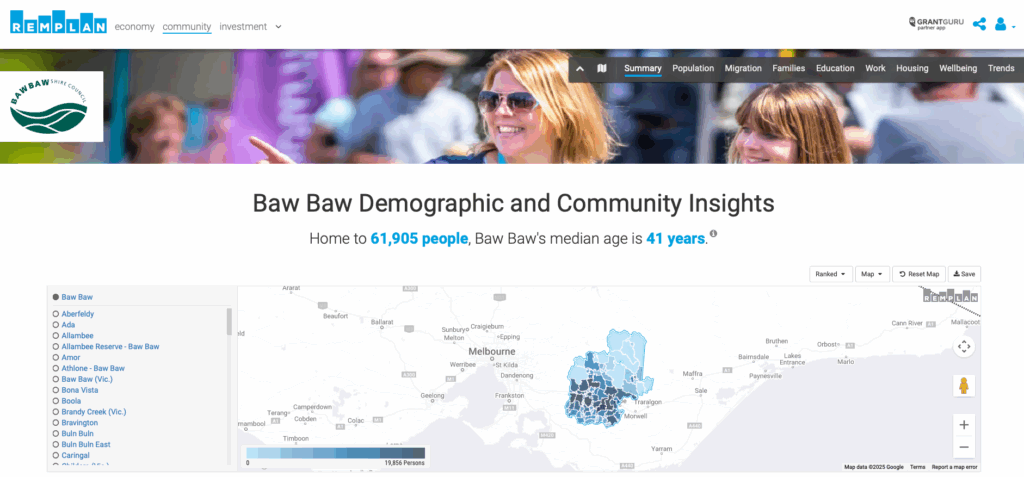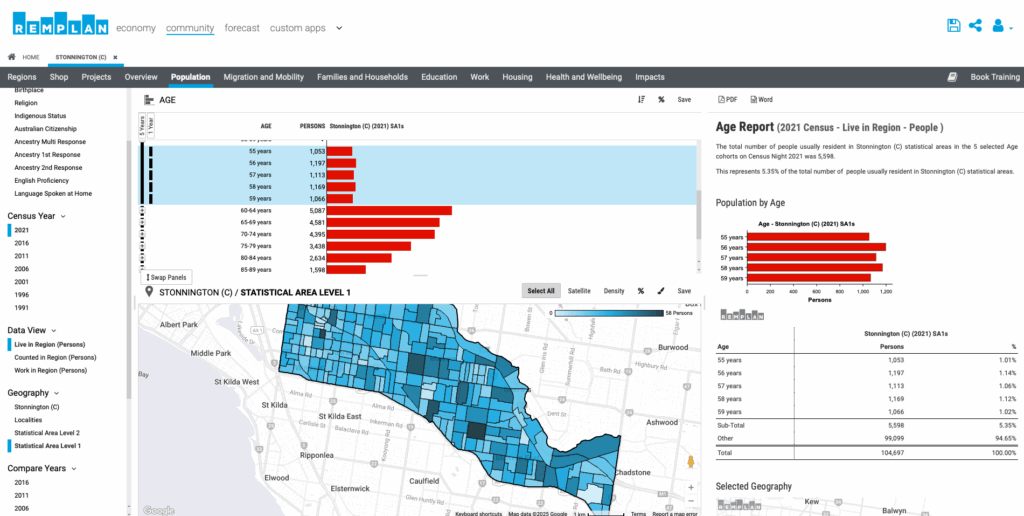03 Jun Unlocking Strategic Insights from Australia’s World-Class Data

Authored by:
Matthew Nichol
Principal Economist
The ABS Census stands as one of the most trusted and comprehensive sources of population and housing information in the world. Conducted every five years, it captures a detailed snapshot of the nation, offering valuable insights into demographics, housing, employment, education, cultural diversity, and more.
For local, state, and federal governments, this data is indispensable. It provides the evidence base needed for:
- Identifying service gaps in health, education, housing and transport.
- Targeting economic development initiatives by understanding local workforce dynamics.
- Planning for infrastructure and community services that reflect population needs.
- Supporting grant applications and funding bids with robust, localised data.
- Tracking change over time, enabling adaptive strategies and long-term planning.
In contrast to countries like the China and the USA, where the Census is conducted every ten years, Australia’s five-year cycle ensures fresher data, supporting more responsive and timely decision-making.
ABS Data is Amazing! High Response Rates, Rich Data
Australia boasts one of the highest Census response rates globally, contributing to exceptionally high-quality, representative data. The 2021 Census achieved a national response rate of over 96%, ensuring that strategic decisions made using this dataset are grounded in accuracy and inclusivity.
This reliability gives planners confidence when using Census data to:
- Segment populations by age, income, or cultural background.
- Assess socio-economic indicators.
- Monitor migration and settlement patterns.
- Evaluate housing stress or education attainment levels.
Quirks and Idiosyncrasies
By objective world standards, the ABS Census data is of high quality and is representative of Australian communities. Nevertheless, it has its quirks and idiosyncrasies. For example:
- The ABS randomises cohorts (e.g. 5-year age groups) independently of totals
- Cohorts in aggregate do not reconcile with totals
- ABS population estimates for a region (e.g. local government area) do not reconcile when the same region is broken down by sub-regions
- ABS Small Area boundaries (e.g. SA1s) do not align with administrative boundaries (e.g. local government areas)
- Cohort estimates for small areas, when aggregated, do not reconcile with the same cohort estimates for the corresponding larger areas.
Cohesion and Consistency
Addressing the quirks and idiosyncrasies detailed above is a key focus of REMPLAN’s Data Science team. The team applies advanced data scaling methodologies to the ABS Census that uses statistical techniques to ensure consistency across different Australian Bureau of Statistics (ABS) geographical levels and demographic categories.
The scaling process applies proportional adjustments to Census data which achieves the consistency objectives, while preserving the underlying patterns, relationships and narratives evident in the original ABS data. For transparency, the original, unscaled ABS demographic data is also presented via REMPLAN software.
The result for clients is significant time savings, with beautifully cohesive and consistent data across all geographies and demographic variables, supporting sucessful project outcomes.
See the Approach in Action
REMPLAN Community leverages this gold-standard, cohesive and consistent demographic data to provide two tiers of access.
1. Community Profiles
These are public-access, online profiles that deliver easy-to-use insights to councils, stakeholders, businesses and the general public. They provide:
- Simple user experience for effortless navigation.
- Accessible visualisations and commentary for clear understanding.
- Narrative-rich analysis contextualising raw data to support evidence-based decision making.
These resources and insights are ideal for community engagement, supporting transparency and inclusivity in planning discussions.Explore community profiles for regions across Australia:
https://app.remplan.com.au/?pt=CommunityProfile

2. REMPLAN Community Software
For those requiring deeper insights, the secure login version of REMPLAN Community offers:
- Interactive mapping capabilities across small to large geographies
- Customisable geographies for targeted planning.
- Detailed demographic insights
- Advanced demographic modelling tools
- Population and housing scenario analysis
- Travel-time catchment analysis
- Time-series and benchmark comparisons
- Projects that can be saved in the software and shared with colleagues.
This platform is particularly useful for strategic planners, policy makers and analysts tasked with long-term development strategies and comprehensive community needs assessments.
Client login: https://login.remplan.com.au/community/

Strong Communities Start with Evidence-based Decisions
By combining the depth and credibility of ABS Census data with REMPLAN’s data science capabilities and intuitive digital platforms, governments gain a powerful ally in strategic planning. Whether the goal is shaping liveability frameworks, directing investment, or fostering community wellbeing, REMPLAN Community ensures that decisions are data-driven, timely and locally relevant.
Thousands of people across Australia apply REMPLAN Community profiles and software to support their work and decision-making.
Want to learn more? Contact the REMPLAN team to arrange a demonstration
Work is underway at REMPLAN in preparation for the 2026 ABS Census of Population and Housing. Are there new insights, reports and features you would like to see in in REMPLAN? We would love to hear from you! Contact Us




No Comments